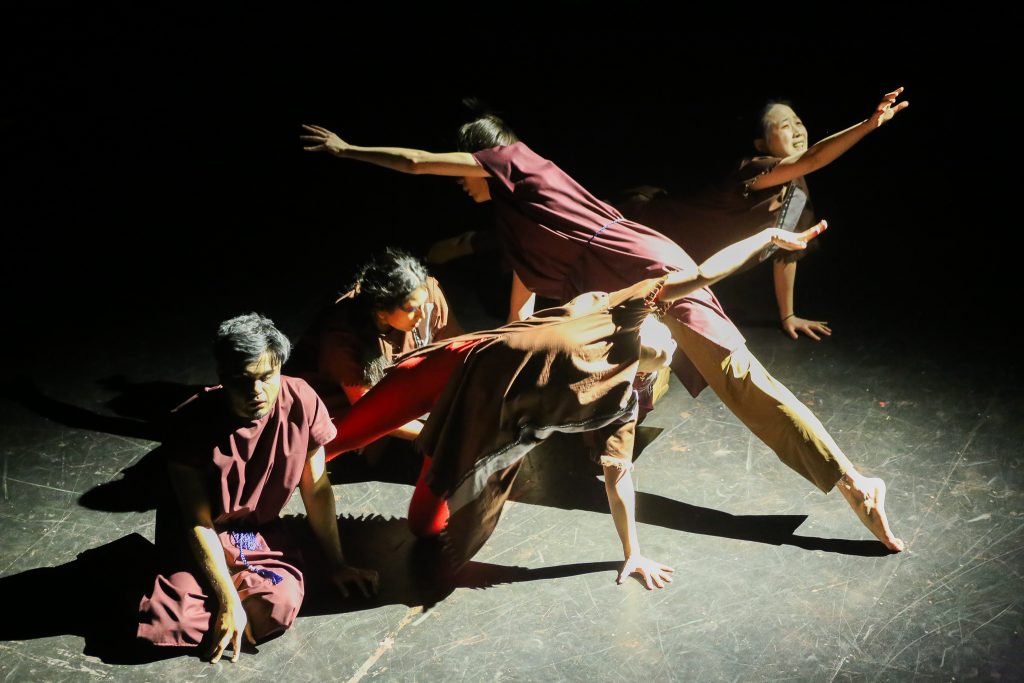The department of theatre at Binghamton University showcased one of its spring studio projects, In The Works – Choreography, producing two captivating performances — “Andha – The Blind” and “Pandemonium.”
Performed in Studio A at BU’s Fine Arts Building from March 21 to March 23 at 8 p.m. and March 24 at 2 p.m., the ushers welcomed the eager audience half an hour before the curtains went up, with dim lights and silence creating an air of anticipation. The production began with the choreography of “Andha – The Blind,” a dance drama inspired by Sophocles’ “Oedipus Rex,” in which the protagonist, Oedipus, is prophesied to kill his father and marry his own mother.
Departing from the Greek influences of the play, director and choreographer Jithendra Vidyapathy, a first-year graduate student in the theatre program, experimented with the performance by including influences from South Asian culture.
“To bring this production to life, I have incorporated both dance and vocal dialogues,” Vidyapathy wrote in an email. “The choreography is a blend of Sri Lankan classical Kandyan dance form, contemporary dance, Indian dance and freestyle dance with gestures to convey the story. However, in some scenes, I have used text to help the audience understand the story.”
The influences of Vidyapathy’s roots were observed in the soundtrack chosen for “Andha – The Blind” and the costumes for his actors and dancers, designed by his father, Ravibandhu Vidyapathy, who is a dancer, drummer, percussionist, musician, painter and costume designer.
“I created the music for my play using a mix of Sri Lankan drums, folk tunes and Western orchestration,” Vidyapathy wrote. “This allowed me to choreograph the dance sequence with more emotional depth and relevance to the story.”
Aiming for the costumes to have Greek influence with a Sri Lankan touch, the character Jocasta, the mother of Oedipus, wore a traditional Sri Lankan costume known as a saree commonly found in Sri Lanka and India which women wear for special occasions. Likewise, the costume of the character Teiresias, the blind prophet who prophesied about Oedipus’s incest, was another traditional South Asian outfit called a salwar.
Vidyapthay delved into the cultural inspiration behind the costumes and design.
“I wanted to showcase Sri Lankan culture on the modern stage through Jocasta’s costume,” Vidyapthay wrote. “My aim was to offer the audience a unique experience of a Sri Lankan dance-theatre production combining traditional and contemporary dance to retell a familiar Greek story using Sri Lankan music and drumming.”
Following a 10-minute intermission, the ensemble of “Pandemonium,” directed by Erica Gundersen, a senior majoring in theatre, took to the stage. A passionate reimagination of Dante Alighieri’s “Inferno” by protagonists Dante and Virgil, the intricate display of ballet followed Dante’s journey under Virgil’s guidance through the nine circles of hell.
Gundersen described how one of Hozier’s albums helped to draw inspiration for her own choreography.
“I was thrilled to discover that one of my favorite musicians, Hozier, had created an album inspired by Dante’s work,” Gundersen wrote in an email. “It felt like two artistic worlds colliding in the most harmonious manner imaginable.”
Gundersen further explained how designing the choreography was a journey of discovery. Each piece of music from Hozier’s album represented a different layer of Dante’s infernal journey and highlighted various characters and themes that resonate with Dante’s “Inferno.”
“Just as the novel traces Dante’s descent through the circles of hell, my show seeks to mirror this journey through the medium of dance, inviting audiences to embark on a transformative experience of their own,” Gundersen wrote.
Gundersen mentioned how assembling an ensemble of 14 talented dancers was not an easy feat, contrary to the effortlessness displayed on the night of their performance.
“It was my responsibility to communicate the vision and concept of my production to the dancers before and during auditions,” Gundersen wrote. “From the outset, I emphasized the diverse styles and thematic elements present in the choreography, and I was delighted to see the dancers’ eagerness to embrace these challenges. The selection of my two protagonists was guided by their innate storytelling abilities, complemented by their exceptional technical skills.”
Sydney Vandermast, the lead dancer of “Pandemonium” and a sophomore majoring in philosophy, politics and law, described how she and the other dancers learned their choreography in time for the show.
“While preparing for ‘Pandemonium,’ it was newer to me to be in such a time crunch, having only a couple weeks to prepare, but it was a challenge that I enjoyed,” Vandermast wrote in an email. “What was unique about the process was that many of the groups were split in order to learn all of the choreography, and our full company only met once a week to put it all together. Through preparation for the show, it was so rewarding to see all the pieces come together into a cohesive show. Overall, it was wonderful to see Erica prepare her piece and work with all the other dancers to make it come to life.”
Gundersen explained what she hopes attendees take away from the performance.
“My hope is that the audience will be swept away by the emotional depth and visceral power of our production, leaving them with a renewed appreciation for the enduring relevance of dance as a medium for storytelling and self-expression,” Gundersen wrote.



